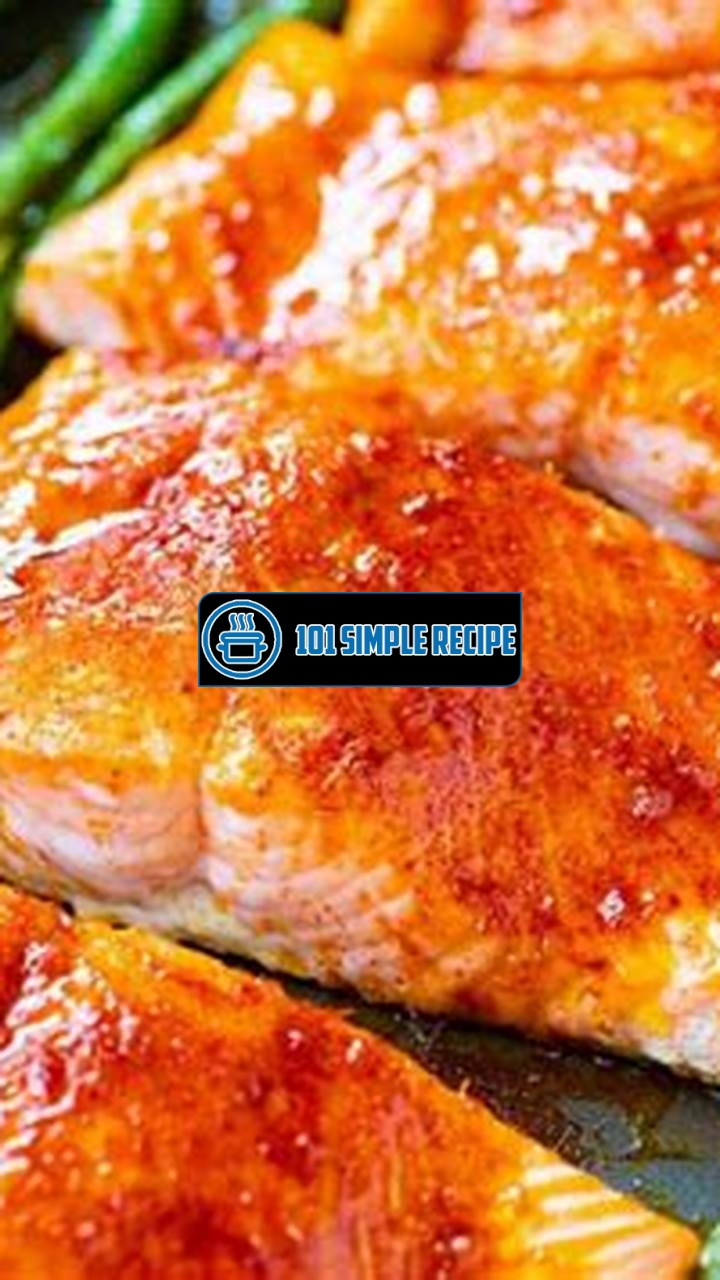Welcome to the world of perfect baked salmon! If you’ve ever struggled with getting the temperature just right when cooking this delicious fish, fear no more. In this article, we will guide you through the process of mastering the perfect baked salmon temperature. But first, let’s take a moment to appreciate the beauty of this mouthwatering dish. Imagine a perfectly cooked piece of salmon with a crispy golden crust, tender and juicy on the inside. Hungry yet? Get ready to dive into the secrets of achieving salmon perfection!

The Importance of Baked Salmon Temperature
Discover why achieving the right temperature is crucial for perfectly cooked, flavorful baked salmon.
Why Temperature Matters
When it comes to cooking salmon, temperature plays a vital role in ensuring a delicious and satisfying meal. The right temperature allows the salmon to cook evenly, retaining its natural flavors and moisture. Cooking salmon at too high a temperature can result in dry, overcooked fish, while cooking at too low a temperature can leave the fish undercooked and potentially unsafe to eat.
By paying attention to the temperature at which you bake your salmon, you can achieve the perfect balance of flavors and textures. Whether you prefer your salmon medium-rare, medium, or well-done, controlling the temperature is the key to getting it just right.
Optimal Temperature for Baked Salmon
The optimal baking temperature for salmon largely depends on personal preference and the desired doneness. However, a general guideline is to bake salmon at a temperature between 375°F (190°C) and 425°F (218°C).
For salmon that is still slightly pink in the center and flakes easily, a lower temperature of around 375°F (190°C) may be preferred. This can preserve the tenderness and juiciness of the salmon while ensuring it is fully cooked. On the other hand, if you prefer your salmon to have a more well-done texture with a slightly crisp exterior, baking at a higher temperature of around 425°F (218°C) can help achieve that result.
It is important to note that the thickness of the salmon fillet also affects the baking temperature and time. Thicker fillets may require a slightly lower temperature and longer cooking time to ensure even cooking. To be certain that the salmon is cooked to the desired temperature, it is recommended to use a food thermometer. The internal temperature of fully cooked salmon should reach 145°F (63°C).
Factors Affecting Salmon Temperature
Several factors can influence the temperature of the salmon as it bakes in the oven. One important factor is the initial temperature of the salmon before it enters the oven. Letting the salmon sit at room temperature for about 20 minutes before baking can help ensure more even cooking.
The thickness and size of the salmon fillet also play a role in determining the baking temperature. Thicker fillets will require more time in the oven and may benefit from a lower temperature to prevent overcooking the exterior while the center remains undercooked.
The type of baking dish used can also affect the temperature of the salmon. Glass or ceramic dishes tend to absorb and retain heat more efficiently than metal pans, resulting in a slightly higher cooking temperature. Adjustments may need to be made to the baking time and temperature depending on the type of dish used.
Lastly, the doneness and texture preferences of the individual also impact the baking temperature. Some may prefer their salmon to be more rare in the center, while others enjoy a fully cooked and flaky texture. Experimenting with different temperatures will help you discover your preferred level of doneness.
In conclusion, the perfect baked salmon temperature is a crucial element in achieving a flavorful and well-cooked dish. By understanding why temperature matters, determining the optimal temperature, and considering the factors that affect salmon temperature, you can master the art of baking salmon to perfection every time. So grab your salmon fillets, set your oven, and get ready to enjoy a delicious meal!
If you’re looking for a delicious recipe for baked salmon, you should try this one from 101 Simple Recipe. It’s a simple and easy-to-follow recipe that yields perfectly cooked salmon every time.
Understanding the Baking Process
When it comes to mastering the perfect baked salmon temperature, understanding the baking process is crucial. This will ensure that your salmon reaches the ideal temperature, resulting in a mouthwatering and perfectly cooked fish.
Preheating the Oven
The first step in achieving the ideal temperature for baked salmon starts with preheating your oven. Preheat your oven to 425°F (218°C) to ensure that it reaches the desired temperature when you place the salmon inside. This high heat will help to sear the exterior of the fish, sealing in the flavors and juices.
Preparing the Salmon
Properly preparing the salmon before baking is key to achieving the perfect temperature. Start by patting the salmon dry with paper towels to remove any moisture. This will allow the salmon to develop a crisp exterior when cooked. Next, season the salmon with your choice of spices or marinades to enhance the flavor. Ensure that the seasoning is evenly distributed on both sides of the fish for consistent taste.
If you prefer a crust on your salmon, you can also coat it with breadcrumbs or a mixture of herbs and spices. This will add an extra layer of texture and flavor to your baked salmon. Don’t forget to add a drizzle of olive oil to keep the fish moist during the baking process.
Baking Techniques for Temperature Control
When it comes to baking salmon, there are different techniques you can use to ensure temperature control and achieve the perfect doneness.
- Baking on a sheet pan: Place the seasoned salmon on a greased or lined sheet pan, skin side down. This ensures even heat distribution and prevents the fish from sticking to the pan. Bake for about 12-15 minutes or until the internal temperature reaches 145°F (63°C). This method is ideal for fillets or smaller cuts of salmon.
- Parchment paper method: Instead of baking directly on a sheet pan, you can also use parchment paper. This method helps to trap moisture around the salmon, resulting in a more tender and flavorful dish. Simply place the seasoned salmon fillets on a sheet of parchment paper and fold the edges to create a packet. Bake for around 15-18 minutes or until the internal temperature reaches 145°F (63°C).
- Foil packet method: Another popular technique for baking salmon is using foil packets. Similar to the parchment paper method, this helps to lock in the moisture and flavors. Place the seasoned salmon on a sheet of aluminum foil and fold the edges to create a sealed packet. Bake for approximately 20-25 minutes or until the internal temperature reaches 145°F (63°C).
Note: It’s important to note that the cooking time may vary depending on the thickness of the salmon fillets. It’s always recommended to use a meat thermometer to ensure that the internal temperature reaches the desired milestone for safe consumption.
By following these key steps and techniques, you’ll be able to master the art of baking salmon to perfection. Remember to experiment with different seasonings and cooking methods to create a variety of delicious and satisfying dishes. Happy baking!
Signs of Undercooked and Overcooked Salmon
When cooking salmon, it’s crucial to achieve the perfect temperature to ensure it is cooked just right. Undercooked salmon can be unsafe to consume, as it may contain harmful bacteria, while overcooked salmon can become dry and tough. Therefore, it’s important to be aware of the visual and textural cues that indicate when salmon is undercooked or overcooked. These cues will help you determine the doneness of your salmon and ensure it turns out delicious every time.
Visual Indicators of Undercooked Salmon
There are several visual cues that can help you identify if your salmon is undercooked. One of the primary indicators is the color of the fish. Undercooked salmon will typically appear translucent and will have a shiny, raw appearance. When you cut into the salmon, it may still have a slightly translucent center. Additionally, the flesh of undercooked salmon will not flake easily and may still appear somewhat raw.
Important: If you notice any of these visual indicators, it’s crucial to continue cooking the salmon until it reaches the appropriate temperature. Consuming undercooked salmon can pose health risks.
Visual Indicators of Overcooked Salmon
On the other hand, it’s equally important to avoid overcooking your salmon. Overcooked salmon tends to have distinct visual cues as well. One noticeable sign is an opaque color throughout the flesh. The salmon may appear dry and have a grayish-brown hue. Furthermore, overcooked salmon can often develop a white substance known as albumin on the surface, which is an indication of overcooking.
Important: If you come across these visual signs, your salmon has been overcooked. It’s essential to pay close attention to the cooking time and temperature to prevent this from happening.
Textural Changes in Undercooked and Overcooked Salmon
Besides visual indicators, the texture of the salmon can also provide valuable insight into its doneness. Undercooked salmon will have a soft and almost mushy texture, indicating that it hasn’t reached its optimal temperature and is not fully cooked. On the other hand, overcooked salmon will be dry, flaky, and may fall apart easily. It can also have a tough and chewy consistency, which signals that it has been cooked beyond the desired point.
Important: By paying attention to the texture, you can determine whether your salmon is undercooked or overcooked. Strive for a tender, flaky texture that is moist and easy to eat.
Mastering the perfect baked salmon temperature requires careful observation of visual and textural cues. By familiarizing yourself with these indicators, you can ensure that your salmon is cooked to perfection every time. Remember, properly cooked salmon will have a firm, flaky texture and a vibrant, opaque color. Enjoy your deliciously cooked salmon with confidence!
If you’re looking for something unique, you might want to try this punch bowl recipe from 101 Simple Recipe. It’s a refreshing and flavorful dish that pairs well with baked salmon.
Tips for Achieving the Perfect Temperature
When it comes to cooking salmon, achieving the perfect temperature is crucial for a delectable and moist dish. Whether you are a seasoned chef or a beginner in the kitchen, you can master the art of baking salmon to perfection every time with the help of these expert tips and tricks.
Using a Meat Thermometer
One of the most reliable ways to ensure your baked salmon reaches the perfect temperature is by using a meat thermometer. This handy tool allows you to accurately gauge the internal temperature of the fish, ensuring it is cooked to perfection and safe to eat.
When using a meat thermometer, insert it into the thickest part of the salmon, making sure to avoid touching the bone. The ideal temperature for fully cooked salmon is 145°F (63°C). Once the desired temperature is reached, remove the salmon from the oven to prevent overcooking.
Note: It is essential to invest in a good quality meat thermometer to ensure accurate temperature readings.
Tip: If you don’t have a meat thermometer, you can still achieve the perfect temperature by keeping a close eye on the texture of the fish. Fully cooked salmon will be opaque and easily flakes apart with a fork.
Resting Period after Baking
After removing the salmon from the oven, it is important to allow it to rest for a few minutes before serving. This resting period allows the residual heat to distribute evenly throughout the fish, ensuring a moist and flavorful outcome.
During the resting period, cover the salmon loosely with aluminum foil to help retain its heat. This will also prevent the fish from drying out while it settles.
Note: The resting period for salmon should be approximately 5 minutes for every inch of thickness.
Tip: Use this resting time to prepare a delicious sauce or side dishes to complement your perfectly cooked salmon.
Other Factors to Consider for Ideal Temperature
In addition to using a meat thermometer and allowing for a resting period, there are other factors to consider when aiming for the ideal temperature for your baked salmon.
- Start with high-quality salmon: Choose fresh salmon fillets that are firm, moist, and have a mild aroma. High-quality salmon will result in a better-tasting dish.
- Thickness of the salmon: Thicker cuts of salmon may require longer cooking times. Adjust your cooking time accordingly to ensure the salmon is fully cooked.
- Oven temperature: Preheat your oven to the recommended temperature before baking the salmon. Consistent oven temperature is crucial for even cooking.
- Marinating or seasoning: Enhance the flavor of your baked salmon by marinating it or adding your favorite seasonings. This will add an extra layer of deliciousness.
Tip: Experiment with different flavors and seasonings to find your favorite combination for a mouthwatering baked salmon dish.
By following these tips and tricks, you can confidently achieve the perfect temperature for your baked salmon, resulting in a succulent and flavorful meal every time. Whether you are cooking for yourself or entertaining guests, mastering the art of baking salmon will surely impress anyone who takes a bite.
Optimal Baked Salmon Temperature Recipes
When it comes to preparing a perfectly baked salmon, achieving the ideal temperature is crucial. Whether you prefer a herb-crusted, honey glazed, or teriyaki flavored salmon, knowing the right temperature to cook it at ensures a moist and flavorful dish. In this article, we will explore three delicious recipes that provide specific instructions for achieving the perfect baked salmon temperature.
Herb-Crusted Baked Salmon
Elevate your salmon dish with a delectable herb crust that adds an extra layer of flavor. To achieve the ideal temperature for this recipe, preheat your oven to 425°F (218°C). This high heat will ensure that the salmon cooks evenly and develops a crispy crust on the outside. Place the herb-crusted salmon on a baking sheet lined with parchment paper, then bake it for approximately 12-15 minutes. Remember to use a food thermometer to check the internal temperature, which should reach 145°F (63°C) to guarantee a perfectly cooked salmon.
Honey Glazed Baked Salmon
Add a touch of sweetness to your salmon with a luscious honey glaze. For this recipe, it is essential to bake the salmon at a slightly lower temperature to allow the glaze to caramelize without burning. Preheat your oven to 375°F (190°C) and line a baking dish with aluminum foil. Place the salmon in the dish, then generously brush it with the honey glaze. Bake the salmon for around 15-20 minutes, or until the internal temperature registers at 145°F (63°C) on a food thermometer. This will result in a succulent and flavorful salmon with a beautiful honey glaze.
Teriyaki Baked Salmon
Transport your taste buds to Japan with a mouthwatering teriyaki baked salmon. To achieve the perfect balance of flavors, it is crucial to cook the salmon at a moderate temperature. Preheat your oven to 350°F (177°C) and prepare a baking dish lined with foil. Place the salmon in the dish and pour the teriyaki sauce over it, making sure to evenly coat the fish. Bake the salmon for approximately 20-25 minutes, or until it reaches an internal temperature of 145°F (63°C). This will result in a tender and juicy salmon with a delightful teriyaki glaze.
Mastering the perfect baked salmon temperature allows you to enjoy a moist and flavorful dish every time. Whether you opt for a herb-crusted, honey glazed, or teriyaki flavored salmon, following the specific temperature instructions ensures excellent results. Try these recipes and savor the deliciousness of a perfectly cooked salmon. Bon appétit!
For a healthy option, you can also check out this weight loss recipe from 101 Simple Recipe. It’s a great way to incorporate salmon into your diet while watching your calorie intake.
Frequently Asked Questions
If you still have questions about the optimal temperature for baking salmon, here are some commonly asked questions:
| No. | Questions | Answers |
|---|---|---|
| 1. | What is the ideal temperature for baking salmon? | The ideal temperature for baking salmon is 375°F (190°C). This allows the salmon to cook evenly while retaining its moisture and flavor. |
| 2. | How long do I bake salmon at 375°F? | The baking time for salmon at 375°F depends on the thickness of the fillet. As a general rule, bake for approximately 12-15 minutes per inch of thickness. |
| 3. | How can I test if my baked salmon is cooked through? | To test if your baked salmon is cooked through, use a fork to gently flake the fish. It should easily separate into large, opaque flakes. The internal temperature should reach 145°F (63°C). |
| 4. | Can I bake salmon at a higher temperature for faster cooking? | While you can bake salmon at a higher temperature for faster cooking, it is not recommended. Higher temperatures can cause the salmon to dry out and lose its tenderness. Stick to 375°F for the best results. |
| 5. | Should I cover the salmon while baking? | It is not necessary to cover the salmon while baking. Leaving it uncovered allows the heat to circulate around the fish, ensuring even cooking and a nicely browned exterior. |
| 6. | What seasonings go well with baked salmon? | Popular seasonings for baked salmon include lemon zest, dill, garlic, and black pepper. You can also try adding a touch of soy sauce or maple syrup for extra flavor. |
Thanks for Reading!
We hope you found this article on the optimal temperature for baking salmon informative and helpful. Remember, baking salmon at 375°F (190°C) will give you moist and flavorful results. Whether you’re preparing a simple weeknight dinner or hosting a special gathering, perfectly baked salmon is always a crowd-pleaser. Feel free to bookmark our site and visit again for more delicious recipes and cooking tips. Happy cooking!
Jump to Recipe
Baked Salmon Temperature

Learn the ideal temperature and cooking time for baking salmon to perfection. Follow our simple guidelines and tips for moist and flavorful results every time. Visit our site for more delicious recipes and cooking tips.
- 4 salmon fillets
- 1 tablespoon olive oil
- Salt and pepper to taste
- Optional: lemon wedges (fresh dill)
- Preheat your oven to 375°F (190°C) and line a baking sheet with parchment paper.
- Place the salmon fillets skin-side down on the prepared baking sheet. Drizzle with olive oil and season with salt and pepper. For additional flavor, add a squeeze of lemon juice and sprinkle fresh dill over the fillets.
- Bake the salmon in the preheated oven for 12-15 minutes, or until it easily flakes with a fork and reaches an internal temperature of 145°F (63°C).
- Remove the salmon from the oven and let it rest for a few minutes. Serve hot with your favorite side dishes and enjoy!






